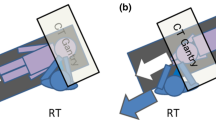Abstract
Objectives
Radiographic examinations have clinical validation/relevance in dental practice. Dentists pay strong attention to absorbed doses to the eye lens, which is located near or inside the irradiation field. Recently, the ICRP recommended a new threshold dose for the eye lens. Therefore, we carried out eye lens dose measurements using a head phantom.
Methods
We affixed fluorescence glass dosimeters to a head phantom and measured the absorbed doses during intraoral radiography, panoramic radiography, cephalography, helical scan computed tomography (helical CT), and dental cone beam computed tomography (dental CBCT).
Results
The mean absorbed dose to the eye lens in intraoral radiography examinations for maxillary incisor teeth and molar teeth was 0.11 ± 0.09 and 0.08 ± 0.04 mGy, respectively. Corresponding values in occlusal method examinations for the maxillary (craniocaudal angulation 70° parallel to the occlusal plane) and mandibular (craniocaudal angulation 90°) regions were 0.19 ± 0.01 and 0.19 ± 0.07 mGy, respectively. The mean value for panoramic radiography examinations was 0.07 ± 0.02 mGy, while that for cephalography examinations in the posteroanterior projection and left lateral projection was 0.02 ± 0.00 and 0.18 ± 0.02 mGy, respectively. The corresponding value for helical CT was 11.87 ± 1.12 mGy, while those for dental CBCT of the front teeth and molar teeth were 0.07 ± 0.02 and 0.12 ± 0.09 mGy, respectively.
Conclusions
Eye lens doses ranged between 0.02 and 0.19 mGy in individual radiographic examinations, including CBCT. Although helical CT recorded 11.87 mGy, it was still lower than the recent ICRP-recommended threshold (500 mGy).


Similar content being viewed by others
References
Arai Y, Tammisalo E, Iwai K, Hashimoto K, Shinoda K. Development of a compact computed tomographic apparatus for dental use. Dentomaxillofac Radiol. 1999;28:245–8.
Guerrero ME, Jacobs R, Loubele M, Schutyser F, Suetens P, van Steenberghe D. State-of-the-art on cone beam CT imaging for preoperative planning of implant placement. Clin Oral Investig. 2006;10:1–7.
Mozzo P, Procacci C, Tacconi A, Martini PT, Andreis IA. A new volumetric CT machine for dental imaging based on the cone-beam technique: preliminary results. Eur Radiol. 1998;8:1558–64.
Patel S, Dawood A, Ford TP, Whaites E. The potential applications of cone beam computed tomography in the management of endodontic problems. Int Endod J. 2007;40:818–30.
Scarfe WC, Farman AG, Sukovic P. Clinical applications of cone-beam computed tomography in dental practice. J Can Dent Assoc. 2006;72:75–80.
Stewart FA, Akleyev AV, Hauer-Jensen M, Hendry JH, Kleiman NJ, Macvittie TJ, et al. ICRP Publication 118: ICRP statement on tissue reactions and early and late effects of radiation in normal tissues and organs—threshold doses for tissue reactions in a radiation protection context. Ann ICRP. 2012;41:1–322.
Diederichs CG, Engelke WGH, Richter B, Hermann KP, Oestmann JW. Must radiation dose for CT of the maxilla and mandible be higher than that for conventional panoramic radiography? AJNR Am J Neuroradiol. 1996;17:1758–60.
Ludlow JB, Ivanovic M. Comparative dosimetry of dental CBCT devices and 64-slice CT for oral and maxillofacial radiology. Oral Surg Oral Med Oral Pathol Oral Radiol Endod. 2008;106:106–14.
Suomalainen A, Kiljunen T, Käser Y, Peltola J, Kortesniemi M. Dosimetry and image quality of four dental cone beam computed tomography scanners compared with multislice computed tomography scanners. Dentomaxillofac Radiol. 2009;38:367–78.
European Commission. European guidelines on radiation protection in dental radiology. Radiation protection 136. Luxembourg: Office for Official Publications of the European Communities; 2004.
Harris D, Horner K, Gröndahl K, Jacobs R, Helmrot E, Benic GI, et al. E.A.O. guidelines for the use of diagnostic imaging in implant dentistry 2011. A consensus workshop organized by the European Association for Osseointegration at the Medical University of Warsaw. Clin Oral Implants Res. 2011;2012(23):1243–53.
Schilham A, van der Molen AJ, Prokop M, de Jong HW. Overranging at multisection CT: an underestimated source of excess radiation exposure. Radiographics. 2010;30:1057–67.
van der Molen AJ, Geleijns J. Overranging in multisection CT: quantification and relative contribution to dose–comparison of four 16-section CT scanners. Radiology. 2007;242:208–16.
Cohnen M, Kemper J, Möbes O, Pawelzik J, Mödder U. Radiation dose in dental radiology. Eur Radiol. 2002;12:634–7.
Mah JK, Danforth RA, Bumann A, Hatcher D. Radiation absorbed in maxillofacial imaging with a new dental computed tomography device. Oral Surg Oral Med Oral Pathol Oral Radiol Endod. 2003;96:508–13.
Okano T, Harata Y, Sugihara Y, Sakaino R, Tsuchida R, Iwai K, et al. Absorbed and effective doses from cone beam volumetric imaging for implant planning. Dentomaxillofac Radiol. 2009;38:79–85.
Morant JJ, Salvadó M, Hernández-Girón I, Casanovas R, Ortega R, Calzado A. Dosimetry of a cone beam CT device for oral and maxillofacial radiology using Monte Carlo techniques and ICRP adult reference computational phantoms. Dentomaxillofac Radiol. 2013;42:1–9.
Acknowledgements
This work was partly supported by the Department of Radiology, Gunma University Hospital, Ishikita Dental Clinic, and Kotake Dental Clinic.
Author information
Authors and Affiliations
Corresponding author
Ethics declarations
Conflict of interest
Takao Kanzaki, Yasuyuki Takahashi, and Kazuma Yarita declare that they have no conflict of interest.
Human and animal rights statements and informed consent
This article does not contain any studies with human or animal subjects performed by any of the authors.
Rights and permissions
About this article
Cite this article
Kanzaki, T., Takahashi, Y. & Yarita, K. Absorbed dose to the eye lens during dental radiography. Oral Radiol 33, 246–250 (2017). https://doi.org/10.1007/s11282-016-0267-3
Received:
Accepted:
Published:
Issue Date:
DOI: https://doi.org/10.1007/s11282-016-0267-3




